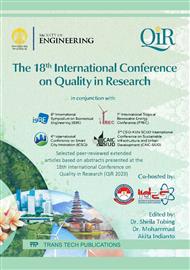[1]
A. Netravali and S. Chabba, "Composites get greener," Materials Today - MATER TODAY, vol. 6, p.22–29, Apr. 2003.
DOI: 10.1016/S1369-7021(03)00427-9
Google Scholar
[2]
M. Y. Khalid, A. Al Rashid, Z. U. Arif, W. Ahmed, H. Arshad, and A. A. Zaidi, "Natural fiber reinforced composites: Sustainable materials for emerging applications," Results in Engineering, vol. 11. Elsevier B.V., Sep. 01, 2021.
DOI: 10.1016/j.rineng.2021.100263
Google Scholar
[3]
A. Yousuf, D. Pirozzi, and F. Sannino, "Fundamentals of lignocellulosic biomass," in Lignocellulosic Biomass to Liquid Biofuels, Elsevier, 2019, p.1–15.
DOI: 10.1016/B978-0-12-815936-1.00001-0
Google Scholar
[4]
S. Kalia, B. S. Kaith, and I. Kaur, "Pretreatments of natural fibers and their application as reinforcing material in polymer composites-a review," Polym Eng Sci, vol. 49, no. 7, p.1253–1272, Jul. 2009.
DOI: 10.1002/pen.21328
Google Scholar
[5]
S. F. Hamad, N. Stehling, S. A. Hayes, J. P. Foreman, and C. Rodenburg, "Exploiting plasma exposed, natural surface nanostructures in ramie fibers for polymer composite applications," Materials, vol. 12, no. 10, May 2019.
DOI: 10.3390/ma12101631
Google Scholar
[6]
A. F. Hamisan, S. Abd-Aziz, K. Kamaruddin, U. K. Md. Shah, N. Shahab, and M. A. Hassan, "Delignification of Oil Palm Empty Fruit Bunch using Chemical and Microbial Pretreatment Methods," International Journal of Agricultural Research, vol. 4, no. 8, p.250–256, Jul. 2009.
DOI: 10.3923/ijar.2009.250.256
Google Scholar
[7]
M. Christwardana, A. S. Handayani, S. Savetlana, R. H. Lumingkewas, and M. Chalid, "Micro-Fibrillated Cellulose Fabrication from Empty Fruit Bunches of Oil Palm," Materials Science Forum, vol. 1000, p.272–277, 2020.
DOI: 10.4028/www.scientific.net/MSF.1000.272
Google Scholar
[8]
D. P. Ferreira, J. Cruz, and R. Fangueiro, "Surface modification of natural fibers in polymer composites," in Green Composites for Automotive Applications, Elsevier, 2018, p.3–41.
DOI: 10.1016/B978-0-08-102177-4.00001-X
Google Scholar
[9]
Y. Husnil, Ismojo, E. Yuanita, A. A. Novovic, T. Enyta, and M. Chalid, "The effect of bleaching treatment on the mechanical strength of PP-Kenaf composite," 2019, p.020051.
DOI: 10.1063/1.5134615
Google Scholar
[10]
E. Yuanita, J. N. Pratama, and M. Chalid, "Preparation of Micro Fibrillated Cellulose Based on Arenga Pinnata 'Ijuk' Fibre for Nucleating Agent of Polypropylene: Characterization, Optimization and Feasibility Study," Macromol Symp, vol. 371, no. 1, p.61–68, Feb. 2017.
DOI: 10.1002/masy.201600039
Google Scholar
[11]
N. A. Latip, A. H. Sofian, M. F. Ali, S. N. Ismail, and D. M. N. D. Idris, "Structural and morphological studies on alkaline pre-treatment of oil palm empty fruit bunch (OPEFB) fiber for composite production," 2018. [Online]. Available: www.sciencedirect.comwww.materialstoday.com/proceedings2214-7853
DOI: 10.1016/j.matpr.2019.06.529
Google Scholar
[12]
M. F. Arif, P. S. M. Megat-Yusoff, and F. Ahmad, "Effects of chemical treatment on oil palm empty fruit bunch reinforced high density polyethylene composites," Journal of Reinforced Plastics and Composites, vol. 29, no. 14, p.2105–2118, Jul. 2010.
DOI: 10.1177/0731684409348976
Google Scholar
[13]
K. Akli, M. Maryam, M. I. Senjawati, and R. A. Ilyas, "Eco-Friendly Bioprocessing Oil Palm Empty Fruit Bunch (Opefb) Fibers Into Nanocrystalline Cellulose (Ncc) Using White-Rot Fungi (Tremetes Versicolor) and Cellulase Enzyme (Trichoderma Reesei)," Journal of Fibers and Polymer Composites, vol. 1, no. 2, p.148–163, Oct. 2022.
DOI: 10.55043/jfpc.v1i2.55
Google Scholar
[14]
A. M. Bin Bujang and N. I. A. B. A. Nordin, "Effect of steam treatment on the characteristics of oil palm empty fruit bunch and its biocomposite," Indonesian Journal of Chemistry, vol. 20, no. 2, p.292–298, 2020.
DOI: 10.22146/ijc.40906
Google Scholar
[15]
A. N. Roziafanto, M. Furqon, N. Sofyan, and M. Chalid, "Micro-Fibrillated Cellulose Prepared from Sorghum Bicolor (L.) Moench by TEMPO-Mediated Oxidation Treatment," 2023, p.9–16.
DOI: 10.1007/978-981-19-4290-7_2
Google Scholar
[16]
N. Reddy and Y. Yang, "Structure and Properties of Natural Cellulose Fibers Obtained from Sorghum Leaves and Stems," J Agric Food Chem, vol. 55, no. 14, p.5569–5574, Jul. 2007.
DOI: 10.1021/jf0707379
Google Scholar
[17]
L. Segal, J. J. Creely, A. E. Martin, and C. M. Conrad, "An Empirical Method for Estimating the Degree of Crystallinity of Native Cellulose Using the X-Ray Diffractometer," Textile Research Journal, vol. 29, no. 10, p.786–794, Oct. 1959.
DOI: 10.1177/004051755902901003
Google Scholar
[18]
J. G. G. de Farias, R. C. Cavalcante, B. R. Canabarro, H. M. Viana, S. Scholz, and R. A. Simão, "Surface lignin removal on coir fibers by plasma treatment for improved adhesion in thermoplastic starch composites," Carbohydr Polym, vol. 165, p.429–436, Jun. 2017.
DOI: 10.1016/j.carbpol.2017.02.042
Google Scholar
[19]
R. Vârban et al., "Comparative FT-IR Prospecting for Cellulose in Stems of Some Fiber Plants: Flax, Velvet Leaf, Hemp and Jute," Applied Sciences, vol. 11, no. 18, p.8570, Sep. 2021.
DOI: 10.3390/app11188570
Google Scholar
[20]
Ismojo, R. Hadiwibowo, A. Zulfia, and M. Chalid, "Feasibility study of pressure boiled method on defibrillation stalk sweet sorghum fibres waste," in Materials Science Forum, Trans Tech Publications Ltd, 2019, p.71–75.
DOI: 10.4028/www.scientific.net/MSF.951.71
Google Scholar
[21]
M. Liu et al., "Controlled retting of hemp fibres: Effect of hydrothermal pre-treatment and enzymatic retting on the mechanical properties of unidirectional hemp/epoxy composites," Compos Part A Appl Sci Manuf, vol. 88, p.253–262, Sep. 2016.
DOI: 10.1016/j.compositesa.2016.06.003
Google Scholar
[22]
M. Ioelovich, "Preparation, characterization and application of amorphized cellulose—a review," Polymers, vol. 13, no. 24. MDPI, Dec. 01, 2021.
DOI: 10.3390/polym13244313
Google Scholar



